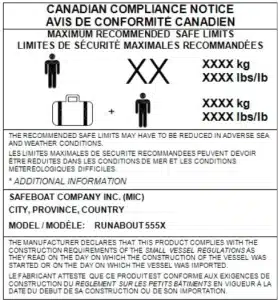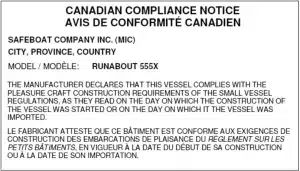10% OFF WITH CODE:
BLACKFRIDAY10
What is a Compliance Notice on a Boat?
April 29, 2025
Updated April 2025 A compliance notice is a guarantee from the manufacturer or importer that a boat meets the construction requirements set out in the Small Vessel Regulations. Manufacturers and importers are responsible for attaching their own compliance notices, which should be based on the format and specifications provided by Transport Canada.
Compliance notice requirements
According to the Small Vessel Regulations, pleasure craft under 24 m that can be fitted with an engine must display a compliance notice in a location that is visible from the helm. There are a few exceptions, including vessels built or imported by an individual for personal use, tugs, and high-powered vessels that are only used for racing.
If a vessel was built after April 29, 2010 and is propelled by an engine but has no compliance notice, the operator should ask the manufacturer or importer to provide one. Pleasure craft operators cannot be fined if a manufacturer or importer fails to attach a compliance notice to their vessel, but removing or altering a compliance notice is prohibited, as is affixing one with incorrect information.
Having a compliance notice from another country or organization is permitted, but it doesn’t replace the requirement for a Canadian compliance notice.
What information is displayed on a boat compliance notice?
For Pleasure Craft Less than 6 Meters (19.7 feet) in length
This is the most common type of compliance notice for recreational boats and includes crucial operational limits:
- Statement of compliance: A declaration that the vessel was built in accordance with the construction requirements of the Small Vessel Regulations at the time of construction or import.
- Maximum number of adults: The maximum number of adult persons that the boat can safely carry.
- Recommended gross load capacity: The maximum total weight the boat is designed to carry, including, persons, gear and equipment, supplies, fuel, motor assembly, steering controls. For boats less than 6 meters these recommendations (load, persons, horsepower) are based on safe operation in good weather conditions. Boaters must always be aware of limitations and never overload the boat, especially in challenging weather.
- Recommended Safe Limits of Engine Power (maximum engine power): If the vessel is designed to be fitted with an outboard engine, this will indicate the maximum permissible horsepower. This is often symbolized by an outboard engine icon.
For Pleasure Craft More than 6 Meters (19.7 feet) in length
For larger pleasure craft, the compliance notice primarily contains:
- Statement of compliance
- Model of the vessel
- Name of the builder, manufacturer, rebuilder, or importer and their manufacturer’s identification code.
- Design limitations (if any)
General Information also found on Compliance Notices (regardless of size)
- Manufacturer’s Identification Code (MIC)
- Model of the vessel
- Hull Identification Number (HIN)
Types of boat compliance notices
Compliance notices for vessels under 6 m
Compliance notices for vessels under 6 m are the same for both pleasure craft and non-pleasure craft, but differ slightly depending on whether the boat is equipped with an outboard, stern-drive or inboard engine. They must contain a statement certifying that the craft meets the construction requirements set out in the Small Vessel Regulations.
Compliance notices for vessels under 6 m are also known as capacity labels, because they set out safe limits for load capacity, engine power and the number of people allowed on board. Note that these limits are based on good weather conditions. In bad weather, such as high winds, it’s best to stay well under capacity and keep to a slow, safe speed to lower the risk of accidents.
Compliance notices for vessels over 6 m
Compliance notices for vessels over 6 m differ depending on whether or not the boat is considered a pleasure craft. The notice must state that the vessel was built in conformity with either pleasure craft or non-pleasure craft construction requirements, whichever applies.
Non-pleasure craft compliance notices indicate that the vessel can also be used as a pleasure craft. However, a pleasure craft over 6 m cannot be used as a non-pleasure craft unless it is modified to comply with the construction requirements of a non-pleasure craft.
(Images of sample compliance notices courtesy of Transport Canada)
Find out more about boating regulations from Drive a Boat Canada!
The compliance notice is just one of the many regulations boaters in Canada need to be aware of. Did you know that you need a boating license to legally operate a boat on Canadian waters? This official proof of competency is called a Pleasure Craft Operator Card.
To obtain their official boating license, prospective boaters must take a safety course provided by a Transport Canada-accredited organization and pass a boating exam online or in person. Register with Drive a Boat Canada today, and learn everything you need to know to pass the test and take to the water legally anywhere in the country!



